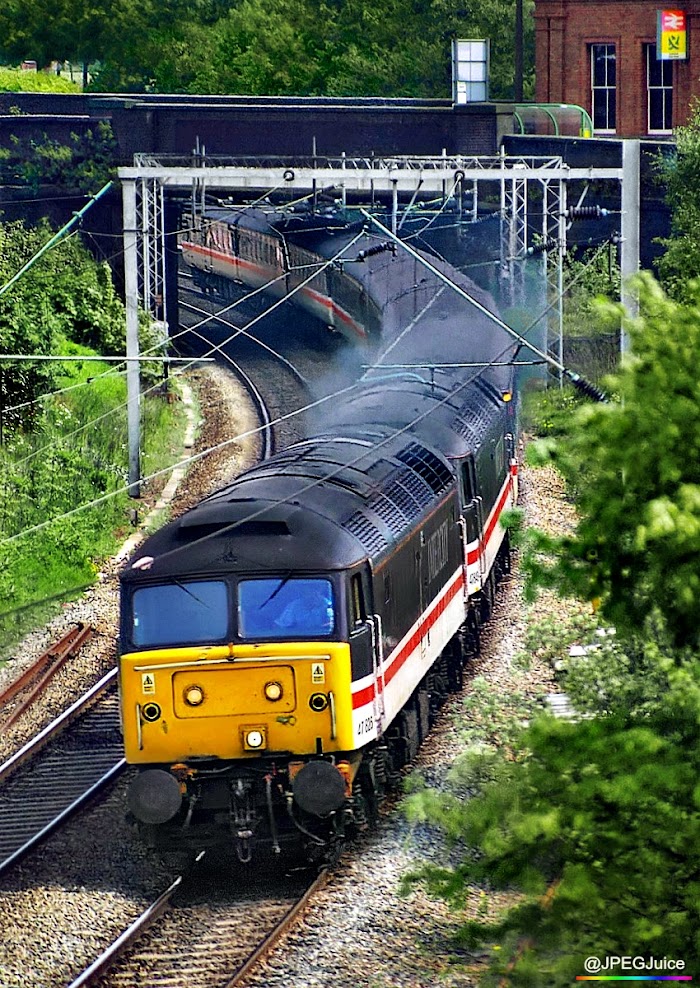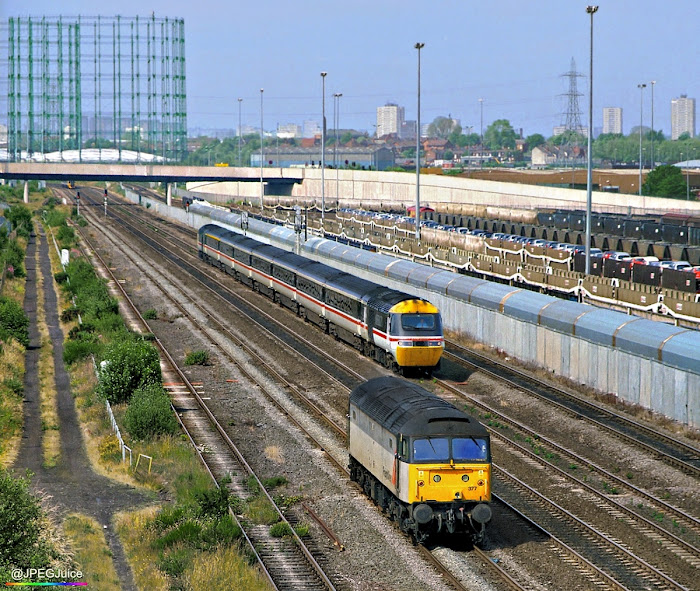"...But the trains that really kickstarted the InterCity era in earnest were the HSTs. After that, BR never looked back."

As was made abundantly clear in Virgin Trains’ famous heritage repaint programme, InterCity livery was a monumental landmark in the history of British Rail’s passenger operations. It ranked alongside two-tone green, corporate blue and large logo as one of the big four nationwide aesthetics adopted by premium passenger diesels. And even though it still hadn’t disappeared from CrossCountry by the year of the repaint programme (2001), InterCity was deemed a classic heritage livery and included in the retro repaint selection alongside the other greats.
In this post we’ll take an illustrated look at the two-decade-long history of InterCity livery, as it appeared on the CrossCountry network. Let’s start at the beginning…

Whether or not the original Inter-City 125 branded livery worn by HSTs can be considered part of the InterCity livery progression, on power cars it was certainly a design template for what subsequently appeared on the IC Executive 43s of 1983. It’s also true that the in-force arrival of HSTs on CrossCountry services, in May 1982, was the point at which the XC network first began to operate as a classic ’80s/’90s InterCity regime.
Only eight months before the CrossCountry HSTs went into full service, CrossCountry trains had still been predominantly steam heated, and had relied on a wide range of traction, with the Class 45/0s and 46s serving as the central diesel component. Lots of Mk.I compartment stock, billowing clouds of vapourised water, and histrionic battles with the Lickey Incline. It all seemed massively outdated, even back in 1981.

Before the XC HSTs went into service, ye olde CrossCountry utilised a motley collection of locomotives.
But starting in September that year, there was a transition period during which BR sought to switch as many steam-heated XC services as possible to electric heating, drafted in air-con rakes for the first time in significant number, and introduced HSTs on a very limited basis.

Initially, the new, updated CrossCountry of the early 1980s would make fairly ample use of the Class 50s. As ETH-fitted locos, the 'Hoovers' could supplement the 45/1s and 47/4s on diesel sections that shared territory with their Western Region home.
By May ’82 when the HSTs began real squadron operation, CrossCountry was a different world from that of the previous spring. The ‘Peaks’ were still heavily involved, as to a lesser extent were the Class 50s, and on electrified sections the Class 81-85 ‘Roarers’ still had a role. But all of this would be phased out through the course of the 1980s. All that would remain by 1989, was a heavily simplified regime comprising HSTs, 47/4s, 86s, and a couple of token 87s. There would be no further significant change to this until 2001, when the Virgin Voyagers were introduced.

Some argue that the production APT was the first InterCity liveried train, although it did not feature the core IC colour of falcon grey. It’s thus more accurate to say that the loco-hauled Manchester Pullman Mk.II stock set of the early 1980s (which did feature falcon grey) was the proto InterCity rake. The loco-hauled Gatwick Express employed another early InterCity liveried stock set. But the trains that really kickstarted the InterCity era in earnest were the HSTs. In autumn 1983, two Western Region sets were treated to a version of the Manchester Pullman’s falcon grey, off white and red, with yellow featuring heavily on the power cars, in keeping with tradition. After that, BR never looked back.
Even without knowing that the HSTs fully kickstarted the era of InterCity livery, the detectives among us could probably have worked it out. Look at the early IC locomotives and you see a rather alien front end styling which bears little sympathy with the loco's features and was clearly blagged wholesale from the paint job on a Class 43…

This first version of InterCity livery is known as InterCity Executive, which conveniently differentiates it from the later version of InterCity. In its complete form, the later version of IC is technically called InterCity Swallow. But, especially since the swallow emblem was sometimes omitted, IC 2.0 is more often referred to simply as InterCity. The Class 87s were only modestly used on XC services, since they were needed by West Coast. The shot above comes from the days when some XC services still comprised full non-air-con rakes. Note that the loco’s early Executive livery has a BR double arrow logo but no actual InterCity branding.

An evocative shot documenting a faded and worn InterCity Executive livery on Class 47/4 No. 47471. The image dates back to 2004, when the loco was stored awaiting disposal at Tyseley. Although there is once again a BR double arrow on this early InterCity incarnation, there is this time a recognition of the InterCity brand.

Bang in the middle of the 1980s, when only a minority of vehicles wore any kind of InterCity livery, it was common to see IC Executive power cars sandwiching regular Rail Blue coaching stock. The stock livery for Executive HST stock was, however, basically the same as the one used in the Swallow era.

For a limited time after InterCity Swallow livery was first introduced in 1987, there were some hybrid variations as paint shops sought to nail the ultimate rendition of the livery. Power car 43004 carried what was almost a full yellow end, along with a very small fleet number near the rear of the bodyside. The swallow symbol was present, but only as a transfer and not as the metal plate which was eventually standardised on HSTs. As the livery was standardised, the yellow cab roof was retained, but the driver’s window surround was mandated as falcon grey. Meanwhile, the fleet number was mandated to the fore section of the cabside and applied at larger size.

The completely unbranded variant of InterCity 2.0 was known as BR Main Line, or simply Main Line – although these terms had to be updated to “original Main Line” or “InterCity Main Line”, to avoid confusion when the Mainline freight business launched. IC Main Line was really just a remnant that arose when IC locos were released from InterCity work and allocated to other duties, but were not due for a repaint into the relevant new livery. In the above 1990 shot, you can see a former InterCity 47/4 which has been transferred to the Parcels sector and de-branded into Main Line livery. Note its cast metal double arrow. Once InterCity 2.0 was standardised, the double arrows were completely dropped in favour of the swallow.

When CrossCountry and other networks dispensed with their steam heat coaching stock, BR needed to convert additional Class 47/0s to ETH-equipped 47/4 status, with new numbers in the 475xx and 476xx series. But a second realm of modification launched in the late 1980s, to increase the fuel capacity, and thus the range, of the CrossCountry 47/4s. This later mod saw the locos renumbered into the 478xx series. They’re referred to as 47/8s, but officially they remained designated as 47/4s. 47827, seen above at Bournville station shortly after conversion, wears the InterCity Main Line livery. It wasn’t strictly necessary to repaint the loco when converting to extended range, so numerous examples initially ran as 47/8s in their previous liveries – including large logo blue and InterCity Executive.

The ultimate, standard version of InterCity livery featured the stylised INTERCITY branding, a swallow logo, and a half yellow end with falcon grey window frames and cab roof. The Class 86s were the staple CrossCountry electric loco by the late 1980s, and they continued to be so until CrossCountry loco haulage came to an end in 2002.

The ultimate incarnation of Intercity livery on the HST is shown above. This late 1990s photo comes from the Virgin Trains era, and reveals its privatised heritage courtesy of the new Class 66 visible on Saltley depot in the background.

In the late 1980s, heading into the 1990s, the InterCity 47s often had full yellow ends, but without the yellow extending to the cabside window frames as it had with standard Rail Blue. 47824 Glorious Devon, seen here at Barnt Green, has the InterCity branding, but no swallow logo. This hybrid livery was lumped in under the Main Line heading in the spotting books of the time. It appears from their description (“As old InterCity but without the yellow cabsides”) that curiously, they considered it a variant of IC Exec rather than a variant of IC Swallow.

By the mid 1990s, InterCity had become heavily standardised as a livery, with very little in the way of detail deviation. So when privatisation arrived, a lot of enthusiasts were more than ready for some livery changes. But despite almost the last six years of CrossCountry loco-haulage falling under the auspices of Virgin Trains, InterCity livery lasted right up until the official end of the loco-hauled timetable in 2002. And even as late as 2000, it was still possible to see not just an IC loco with a full rake of IC stock, but a pair of IC locos with a full rake of IC stock. On 12th May that year, 47826 and 47843 round the curve away from Smethwick Rolfe Street.

Another Virgin era shot above shows an interesting instance of an InterCity liveried train calling at Longbridge station on 22nd August 2000. That month, the remodelling of Proof House Junction made Birmingham New Street inaccessible from the Derby end. Hence, services such as this 06:40 York – Bristol were required to take the Camp Hill line and call at Longbridge, with passengers for New Street then connecting via the Cross-City. The loco is 47854 Women's Royal Voluntary Service.

2000 was the final year in which a full IC liveried HST set could be observed on CrossCountry, and the last two IC power cars disappeared in the first half of 2001. The shot above comes from summer 1999, and shows how transitional that year was. On the one hand, you have a Railfreight grey 47/3 working for Freightliner and a full InterCity HST set working for Virgin XC, and on the other there’s a new EWS 66 in Washwood Heath Yard.

If Virgin Trains weren’t still having at least some Class 86s repainted in InterCity livery throughout their loco-hauled XC era (1997 to 2002), then they had miraculously good cleaning facilities. This shot from 26th November 2001 shows 86214 Sans Pareil looking to have been repainted fairly recently, and certainly more recently than 1997. Another member of the class whose InterCity paintwork looked to have been recently refreshed in 2001 was 86212. And 86228 was clearly ex-works wearing what was technically Main Line livery in September 2002, as can be seen in the shot heading the Virgin Electrics post.

A notable slight return for InterCity livery, albeit only between Birmingham and Cheltenham Spa, came in 2007, when Central Trains hired IC survivor 47826 from West Coast Railways, to work its Cheltenham Races specials from 12th to 16th March. Here’s the train at Barnt Green on Tuesday 13th. 47826 was the last 47 to survive in its original BR InterCity livery, and it had its paintwork fully refreshed in November 2001 as part of Virgin’s heritage repaint programme.
There's a lot more relating to CrossCountry on this blog. One article I haven't yet linked to in this post is the one that recalls the role of the Class 47/7 on CrossCountry. Very much a facet of the Virgin era. But beyond that, start on the home page and have a look around. It's all heavily illustrated.